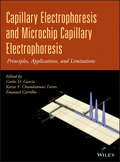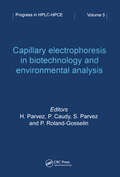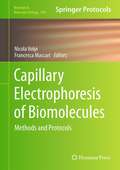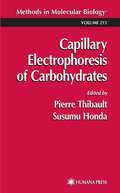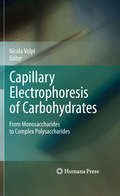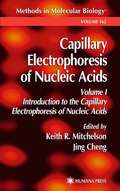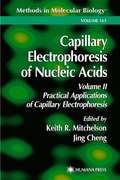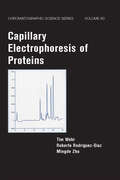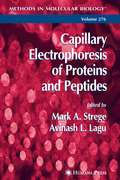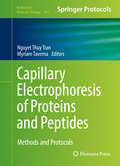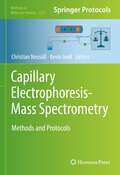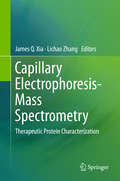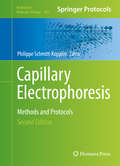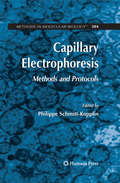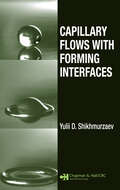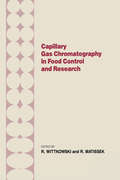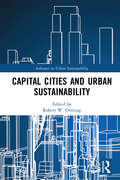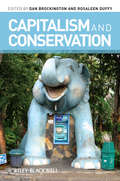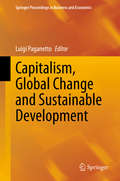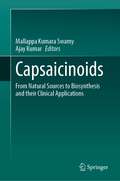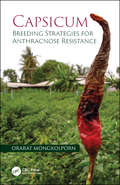- Table View
- List View
Capillary Electrophoresis and Microchip Capillary Electrophoresis
by Emanuel Carrilho Karin Y. Chumbimuni-Torres Carlos D. GarcíaExplores the benefits and limitations of the latest capillary electrophoresis techniquesCapillary electrophoresis and microchip capillary electrophoresis are powerful analytical tools that are particularly suited for separating and analyzing biomolecules. In comparison with traditional analytical techniques, capillary electrophoresis and microchip capillary electrophoresis offer the benefits of speed, small sample and solvent consumption, low cost, and the possibility of miniaturization.With contributions from a team of leading analytical scientists, Capillary Electrophoresis and Microchip Capillary Electrophoresis explains how researchers can take full advantage of all the latest techniques, emphasizing applications in which capillary electrophoresis has proven superiority over other analytical approaches. The authors not only explore the benefits of each technique, but also the limitations, enabling readers to choose the most appropriate technique to analyze a particular sample.The book's twenty-one chapters explore fundamental aspects of electrophoretically driven separations, instrumentation, sampling techniques, separation modes, detection systems, optimization strategies for method development, and applications. Specific topics include:Critical evaluation of the use of surfactants in capillary electrophoresisSampling and quantitative analysis in capillary electrophoresisCapillary electrophoresis with electrochemical detectionOvercoming challenges in using microchip electrophoresis for extended monitoring applicationsCapillary electrophoresis of intact unfractionated heparin and related impuritiesMicrochip capillary electrophoresis for in situ planetary explorationEach chapter begins with an introduction and ends with conclusions as well as references to the primary literature. Novices to the field will find this book an easy-to-follow introduction to core capillary electrophoresis techniques and methods. More experienced investigators can turn to the book for troubleshooting tips and expert advice to guide them through the most advanced applications.
Capillary Electrophoresis in Biotechnology and Environmental Analysis
by H. Parvez P. Caudy S. Parvez P. Roland-GosselinThis text aims to evaluate the actual impact of high-performance capillary electrophoresis on analytical biotechnology and environmental analysis. The first part of the book presents a survey of present innovations in instrument design and different methods of pre-concentration techniques in order to obtain increased separations at higher sensitivities. The second part contains articles on applications of HPCE to protein and peptide analysis. In the third part, applications of HPCE in the investigation of drug abuse and drug interactions are presented. The last two parts of the book deal with the use of HPCE at low-UV wavelengths and negative-UV absorption. The book should be of interest to those working in HPCE research and applications.
Capillary Electrophoresis of Biomolecules: Methods and Protocols (Methods in Molecular Biology #984)
by Nicola Volpi Francesca MaccariCapillary electrophoresis (CE) is a relatively new separation technique suitable for handling small amounts of sample very important in bioanalytical research and in various clinical, diagnostic, genetic, and forensic applications. In Capillary Electrophoresis of Biomolecules: Methods and Protocols, expert researchers in the field provide key techniques to investigate CE focusing on simple and complex carbohydrates (polysaccharides), aminoacids, peptides and proteins, enzymes, and nucleic acids. Along with practical procedures, reviews discussing CE applications related to bio(macro)molecules are also included. Written in the highly successful Methods in Molecular BiologyTM series format, chapters include introductions to their respective topics, lists of the necessary materials and reagents, step-by-step, readily reproducible laboratory protocols, and key tips on troubleshooting and avoiding known pitfalls. Authoritative and practical, Capillary Electrophoresis of Biomolecules: Methods and Protocols provides the reader with the latest break throughs and improvements in CE and CE techniques applied to several classes of bio(macro)molecules.
Capillary Electrophoresis of Carbohydrates (Methods in Molecular Biology #213)
by Pierre Thibault Susumu HondaA collection of cutting-edge techniques for using capillary electrophoresis (CE) to analyze complex carbohydrates. These readily reproducible protocols provide methods for sample preparation, analysis of mono- and oligosaccharides, glycoproteins, and glycoconjugates. A useful appendix describes the structures of the most commonly encountered carbohydrate residues and olgosaccharides from mammalian and bacterial origins. Each protocol contains detailed information on reagents, apparatus, notes, comments, and tips on procedures.
Capillary Electrophoresis of Carbohydrates: From Monosaccharides to Complex Polysaccharides
by Nicola VolpiSimple carbohydrates, complex oligosaccharides and polysaccharides all belong to a class of ubiquitous (macro)molecules that exhibit a wide range of biological functions, and the recent advent of enhanced enzymatic, chemical and analytical tools used to study these sugars has inaugurated a genuine explosion in the field of glycomics. Specifically, it has led to a deeper understanding of how specific sugar structures modulate cellular phenotypes, and that breakthrough has led to the discovery of new pharmaceuticals for the treatment of many serious diseases, such as cancer. The subsequent rapid expansion of this research holds high promise for future therapeutic regimens, and capillary electrophoresis (CE) refers to the range of related separation techniques that are integral to this vital research. CE uses narrow-bore fused-silica capillaries to separate a complex array of large and small molecules, and Capillary Electrophoresis of Carbohydrates offers a comprehensive look at the latest breakthroughs and improvements in CE and CE techniques applied to monosaccharides up to complex oligosaccharides and polysaccharides. It begins with an overview of the application of CE and CE- mass spectrometric in the analysis of simple carbohydrates without any previous derivatization step before discussing various detection techniques such as spectrophotometric detection, electrochemical detection and other less common techniques. It then covers in detail an array of related topics and numerous applications. It is an essential text for anyone exploring the myriad possibilities of this rapidly expanding field.
Capillary Electrophoresis of Nucleic Acids: Introduction To The Capillary Electrophoresis Of Nucleic Acids (Methods in Molecular Biology #162)
by Keith R. Mitchelson Jing ChengAn outstanding panel of hands-on experts and developers of CE equipment describe in step-by-step fashion their best cutting-edge methods for the detection and analysis of DNA mutations and modifications, ranging from precise DNA loci to entire genomes of organisms. This first volume of the set, Introduction to the Capillary Electrophoresis of Nucleic Acids, covers the practical and theoretical considerations behind the use of capillary electrophoresis for the analysis of small oligonucleotides and modified nucleotides. Along with detailed instructions ensuring ready reproducibility, these protocols offer time-tested advice on instrumentation, signal detection, the capillary environment, and the integration of mass spectrometry with CE. Several chapters are devoted to the analysis of small therapeutic oligonucleotides, nucleosides, and ribonucleotides by CE. The companion volume, Practical Applications of Capillary Electrophoresis, addresses techniques for high-throughput analysis of DNA fragments using SNP detection, mutation detection, DNA sequencing methods, and DNA-ligand interactions. Comprehensive and up-to-date, the paired volumes of Capillary Electrophoresis of Nucleic Acids offer an authoritative guide with easy access to fast, versatile, reliable, and powerful technologies for all those basic and clinical investigators analyzing DNA variation today.
Capillary Electrophoresis of Nucleic Acids: Practical Applications Of Capillary Electrophoresis (Methods in Molecular Biology #163)
by Keith R. Mitchelson Jing ChengThe advent of capillary electrophoresis (CE), with its power to separate and analyze very small amounts of DNA, has produced a host of DNA analytical procedures. In the Unprecedentedly wide-ranging volumes of Capillary Electrophoresis of Nucleic Acids, an outstanding panel of hands-on experts and developers of CE equipment describe in step-by-step fashion their best cutting-edge methods for the detection and analysis of DNA mutations and modifications, ranging from precise DNA loci to entire genomes of organisms. This second volume of the set, Practical Applications of Capillary Electrophoresis, covers techniques for high-throughput analysis of DNA fragments using SNP detection, mutation detection, DNA sequencing methods, and DNA-ligand interactions. Several chapters also discuss CE analysis at elevated temperatures and the use of micro-CE and array-CE devices. The companion volume, Introduction to the Capillary Electrophoresis of Nucleic Acids, offers readily reproducible methods for the analysis of small oligonucleotides and modified nucleotides, and time-tested advice on instrumentation, signal detection, the capillary environment, and the integration of mass spectrometry with CE. Comprehensive and up-to-date, the paired volumes of Capillary Electrophoresis of Nucleic Acids offer an authoritative guide with easy access to fast, versatile, reliable, and powerful technologies for all those basic and clinical investigators analyzing DNA variation today.
Capillary Electrophoresis of Proteins (Chromatographic Science Series)
by Tim Wehr Roberto Rodríguez-Díaz Mingde ZhuProvides practical information on the application of capillary electrophoresis (CE) to protein analysis, with an emphasis on developing and optimizing CE techniques in the laboratory. Includes separation methods bases on mass, charge, isoelectric point, molecular sieving, and affinity interactions.
Capillary Electrophoresis of Proteins and Peptides (Methods in Molecular Biology #276)
by Mark A. Strege Avinash L. LaguExpert academic and pharmaceutical researchers describe their best capillary electrophoresis techniques for protein and peptide analysis. The authors present cutting-edge techniques for both capillary coatings and analytic detection via laser-induced fluorescence, for the development and commercialization of biopharmaceuticals, and for affinity capillary electrophoresis in the evaluation of protein binding, including the use of protein charge ladders. Areas of special interest covered include combining CE and capillary isoelectric focusing with electrospray mass spectrometry detection to perform proteomic studies and applications in the field of protein-ligand binding.
Capillary Electrophoresis of Proteins and Peptides: Methods and Protocols (Methods in Molecular Biology #1466)
by Nguyet Thuy Tran Myriam TavernaThis book provides a comprehensive survey of recent developments and applications of high performance capillary electrophoresis in the field of protein and peptide analysis with a distinct focus on the analysis of intact proteins. With practical detail, the contents cover different modes of capillary electrophoresis (CE) useful for protein and peptide analysis, CZE, CIEF, ACE, CGE, and different types of application such as the quality control of therapeutic proteins and monoclonal antibodies, clinical analyses of chemokines in tissues, qualitative and quantitative analysis of vaccine proteins, and determination of binding constants in complexes involving peptides or proteins. Written for the highly successful "Methods in Molecular Biology" series, chapters include introductions to their respective topics, lists of the necessary materials and reagents, step-by-step, readily reproducible laboratory protocols, and tips on troubleshooting and avoiding known pitfalls. Authoritative and exhaustive, "Capillary Electrophoresis of Proteins and Peptides: Methods and Protocols" serves both beginners and experts with a collection of the current and most active topics in this vital field of study.
Capillary Electrophoresis-Mass Spectrometry: Methods and Protocols (Methods in Molecular Biology #2531)
by Christian Neusüß Kevin JooßThis volume details aspects and applications of interfacing capillary electrophoresis (CE) with mass spectrometry (MS). Chapters guide readers through approaches based on different types of CE-MS interfaces such as (nano)sheath liquid, porous tip, and liquid junction, as well as various capillary coatings, and a broad range of applications including several top-down and bottom-up proteomic approaches. Additionally, a list of analyte targets was provided consisting of amphetamines, antibiotics, carbohydrates (including glycosaminoglycans and glycopeptides), enantiomers, extracellular matrix metabolites, monoclonal antibodies, and nanoparticles, and therefore covers numerous fields of applications such as pharmaceutical, biomedical, food, agrochemical, and environmental analysis. Written in the format of the highly successful Methods in Molecular Biology series, each chapter includes an introduction to the topic, lists necessary materials and reagents, includes tips on troubleshooting and known pitfalls, and step-by-step, readily reproducible protocols. Authoritative and cutting-edge, Capillary Electrophoresis-Mass Spectrometry: Methods and Protocols aims to provide highly valuable information for both beginners and experts in the field be it students, technical staff, and scientists.
Capillary Electrophoresis-Mass Spectrometry: Therapeutic Protein Characterization
by James Q. Xia Lichao ZhangThis book covers the latest developments in capillary electrophoresis-mass spectrometry for the analysis of therapeutic proteins. The application of capillary electrophoresis-mass spectrometry (CE-MS) coupling technology in the analysis of recombinant therapeutic proteins is detailed thoroughly. Specific topics include recent developments in coupling capillary electrophoresis with mass spectrometry for the quality control of monoclonal antibody therapeutics, top-down analysis of monoclonal antibody using the CE-MS platform, and detection of host cell protein impurities. Comprehensive characterization of antibody-drug conjugates (ADCs) by coupling capillary electrophoresis with mass spectrometry is also covered. This is an ideal book for scientists in the life science and biopharmaceutical industry who are working on characterizing the PTMs of monoclonal antibodies, as well as graduate students and researchers in the separation science and biological mass spectrometry fields.
Capillary Electrophoresis: Methods and Protocols (Methods in Molecular Biology #1483)
by Philippe Schmitt-KopplinCapillary Electrophoresis: Methods and Protocols presents a selection of current capillary electrophoresis methods used to separate representative types of molecules and particles and in combination with different detection techniques. The volume is intended for beginners in the field and provides overviews of each technique and a starting point for the exploration of the literature on different application topics. As a beginning text, each technique is explained in simple terms, assuming only minimal previous knowledge of the methods. A Notes section accompanies each chapter and addresses problems that may occur and how to overcome them.
Capillary Electrophoresis: Methods and Protocols (Methods in Molecular Biology #384)
by Philippe Schmitt-KopplinThis book presents a selection of current capillary electrophoresis methods used to separate representative types of molecules and particles and in combination with different detection techniques. It includes practical details which are hard to find elsewhere. The volume is intended for beginners in the field and provides an overview of the technique and a starting point for the exploration of the defined literature on different application topics.
Capillary Flows with Forming Interfaces
by Yulii D. ShikhmurzaevCapillary Flows with Forming Interfaces explores numerous theoretical problems that arise in the mathematical description of capillary flows. It focuses on developing a unified approach to a variety of seemingly very different capillary flows of practical importance where classical fluid mechanics leads to nonphysical results.The book begin
Capillary Gas Chromotography in Food Control and Research
by R. WittkowskiThis book offers a comprehensive survey on the possibilities, applications, and new developments of capillary gas chromatography for the complete range of examinations of food and raw material. It is intended for food scientists/chemists, food technologists, and nutritionists.
Capital Cities and Urban Sustainability (Advances in Urban Sustainability)
by Robert W. OrttungCapital Cities and Urban Sustainability examines how capital cities use their unique hub resources to develop and disseminate innovative policy solutions to promote sustainability. Cities are taking a leading role in defining a sustainable future at a time when national, state, and regional governments in several countries do not provide sufficient leadership. Capital cities stand out among cities as likely leading drivers in the effort to empower sustainable innovation as they provide a hub for connecting a variety of key constituencies. While acknowledging the successes capital cities have achieved, the international, multi-disciplinary contributors to this work discuss how there is room to do more and improve. The promotion of specific sustainability policies in crucial areas such as clean water provision, high tech innovation, public procurement contracting, and improving flood control in capital cities is examined through various global case studies. The examples range from relatively rich capital cities, such as Copenhagen, where the well-financed hub would be expected to succeed in generating sustainable policies, to poorer cities such as Phnom Penh, where such an optimistic outcome can seem less likely.
Capital Mysteries #1: Who Cloned the President?
by Ron Roy Liza WoodruffKC Corcoran always watches the news. So it's no surprise that she notices right away when the president starts acting funny on TV. He's stiff and awkward. He's even signing papers with the wrong hand. There's only one explanation-the president has been cloned! And it's up to KC and her best friend, Marshall, to save him.From the Trade Paperback edition.
Capitalism and Conservation: Conservation, Capitalism And The Future Of Protected Areas (Antipode Book Series #45)
by Rosaleen Duffy Dan BrockingtonThrough a series of case studies from around the world, Capitalism and Conservation presents a critique of conservation’s role as a central driver of global capitalism. Features innovative new research on case studies on the connections between capitalism and conservation drawn from all over the world Examines some of our most popular leisure pursuits and consumption habits to uncover the ways they drive and deepen global capitalism Reveals the increase in intensity and variety of forms of capitalist conservation throughout the world
Capitalism and the Commons: Just Commons in the Era of Multiple Crises (Routledge Studies in Global Land and Resource Grabbing)
by Andreas Exner Sarah Kumnig Stephan HochleithnerCapitalism and the Commons focuses on the political and social perspectives that commons offer, how they are appropriated or suppressed by capital and state, and how social initiatives and movements contest these dynamics or build their struggles on commoning. The volume comprises theoretical and empirical approaches that engage with three main themes: conceptualizing the commons, analyzing practices of commoning, and exploring commons politics. In their contributions, the authors focus on the development of anti-capitalist commons and explore the issue of practice and politics through case studies from Colombia, the Democratic Republic of Congo, South Africa, and Africa more broadly, Austria, Germany and South Korea, ranging from peri-urban and rural agriculture to urban commons and how they manifest in the Global South as well as in the Global North. The book engages with different discourses on the commons in regard to their relevance for social change and thereby reinvigorates the political meaning of the commons. It provides an original and important approach to the topic in terms of conceptualization, detailing diverse empirical realities, and analyzing potential perspectives. In so doing, the book transcends narrow disciplinary boundaries and expands the focus to the global. Providing a fresh perspective on the commons as a decisive component of alternatives, this title will be relevant to scholars and students of resource management, social movements, and sustainable development more broadly.
Capitalism, Global Change and Sustainable Development (Springer Proceedings in Business and Economics)
by Luigi PaganettoThis book analyzes new forms of capitalism that are manifesting under the pressures of global transformation. By studying economic and environmental indicators in various parts of the world, it seeks to reconcile economic growth with environmental and social sustainability, which is an important issue in both developed and emerging economies. These indicators include the explosive development of digital technologies and new global value chains, which are reshaping economies and societies all over the world. The contributing authors also address the challenge of immigration, the sustainable development transformation, the ties between productivity and social rights, automation and global value chains, the energy transition, and innovation and sustainable growth.
Capitalizing on Nature
by Edward B. BarbierThe basic unit of nature - the ecosystem - is a special form of wealth, which we can think of as a stock of natural capital. However, perhaps because this capital is free, we have tended to view it as limitless, abundant and always available for our use, exploitation and conversion. Capitalizing on Nature shows how modeling ecosystems as natural capital can help us to analyze the economic behavior that has led to the overuse of so much ecological wealth. It explains how this concept of ecosystem as natural capital sheds light on a number of important issues, including landscape conversion, ecological restoration, ecosystem resilience and collapse, spatial benefits and payments for ecosystem services. The book concludes by focusing on major policy challenges that need to be overcome in order to avert the worsening problem of ecological scarcity and how we can fund novel financing mechanisms for global conservation.
Capsaicinoids: From Natural Sources to Biosynthesis and their Clinical Applications
by Ajay Kumar Mallappa Kumara SwamyThis edited book brings out a comprehensive collection of information on capsaicinoids. Primarily, this book includes compiled knowledge on various aspects of capsaicin from ethnobotany to the most important clinical applications. This book covers topics emphasizing chemistry, biosynthesis, anticancer activities, bioavailability, currently undergoing experimental phases, and biotechnological methods, including cell cultures, and metabolic engineering in heterologous microbial and plant systems to enhance capsaicin production. Capsaicinoids are a group of important compounds that are particularly synthesized by various members of the genus Capsicum in their placenta. Capsaicin is the most abundant vanilloid compound among the different capsaicinoids in hot peppers. Other capsaicinoids include dihydrocapsaicin, nordihydrocapsaicin, homocapsaicin, and homodihydrocapsaicin. The capsaicin has been proven as an important bioactive molecule with several properties against many ailments, such as cancer, diabetes, obesity and diseases of the airway and urinary tract. Capsaicin interacts with TRPV1 receptors in humans. These compounds exert their functions by interacting with the TRPV receptors. This book summarises the increasing literature surrounding capsaicin and helps to pave the way for the development of novel targets for the prevention and treatment of many disorders. It is useful for scientists, clinicians, and industry specialists working in the field of herbal therapeutics. It also assists as supplementary reading material for undergraduate and graduate students of botany, biotechnology, biochemistry, bioengineering, pharmacology, and medicine.
Capsicum: Breeding Strategies for Anthracnose Resistance
by Orarat MongkolpornCapsicum, more commonly as chili or chili pepper, is an important global vegetable and spice crop. Anthracnose disease, caused by a complex of Colletotrichum species, is the major biotic stress limiting chili production in tropical and subtropical countries. Anthracnose disease mainly manifests itself as a post-harvest disease, resulting in large necrotic lesions on the fruit. This disease is mainly controlled by the application of a "cocktail" of fungicides as commercial resistant cultivars are not available. In recent years, insights into the complexity of the pathogen and the genomics of the host have been accomplished using cutting-edge molecular technologies. The author has been at the forefront of this technology revolution in Capsicum breeding through her research to understand the host and pathogen which has led to the development of new anthracnose resistant genotypes. Capsicum: Breeding Strategies for Anthracnose Resistance is structured based on a review of the origin and evolution of Capsicum, Capsicum genetic diversity and germplasm resources, the latest research in the biology and taxonomy of Colletotrichum pathogens of Capsicum, and the classic and molecular breeding for resistance in Capsicum to the suite of Colletotrichum pathogens that infect Capsicum globally. This book brings together knowledge on both the pathogen and the host, which is often overlooked when reviewing the breeding and genetics of a crop plant. It informs the facts behind breeding for resistance from both the host and pathogen perspectives.
Capsicum: The genus Capsicum (Medicinal And Aromatic Plants Industrial Profiles #33)
by Amit Krishna DeCapsicum has been used since ancient times not only as a traditional medicine but also as a natural colorant. The medicinal properties of capsicum make it popular in both ayurvedic and homeopathic treatments.
